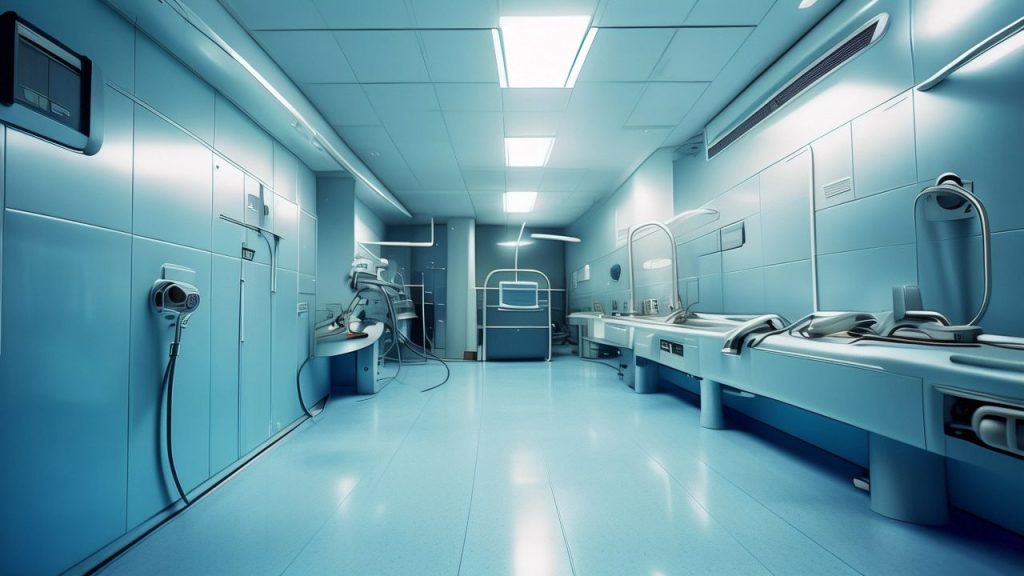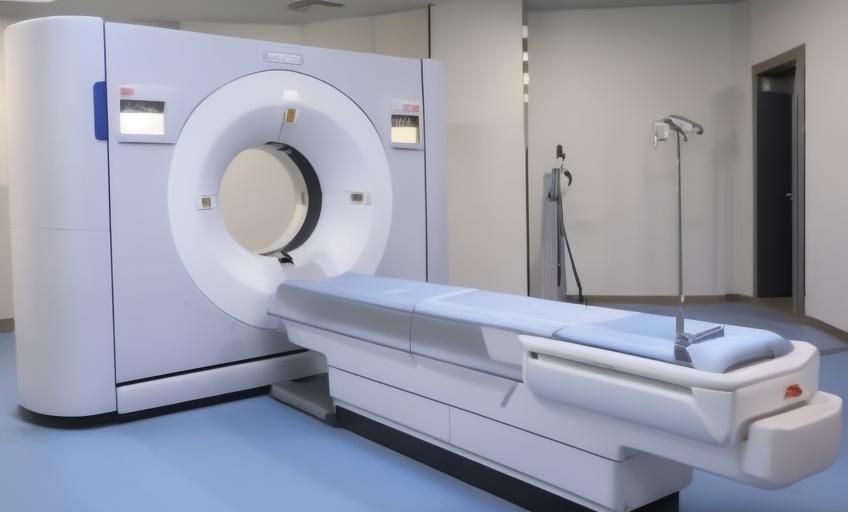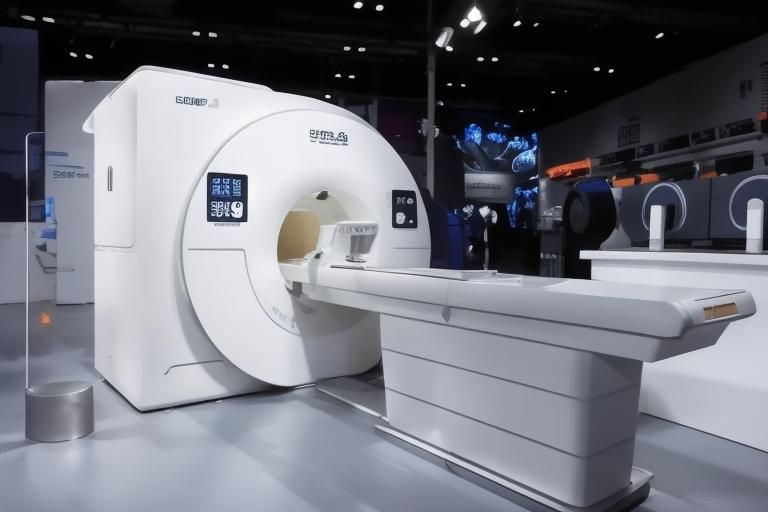CT scan vs MRI:different principles
CT (Computed Tomography) and MRI (Magnetic Resonance Imaging) are both medical imaging techniques used to visualize detailed internal structures of the body. However, they operate on different principles:
- CT Scan: This technique uses X-rays to create detailed images of the body. A CT scanner consists of an X-ray tube that rotates around the patient, emitting X-rays. These X-rays pass through the body and are detected by a set of detectors on the opposite side. The data collected is then processed by a computer to produce cross-sectional images (slices) of the body. The key principle here is the absorption and attenuation of X-rays by different tissues, which varies depending on the density of the tissues.
- MRI: MRI, on the other hand, uses a strong magnetic field and radio waves to generate images. In MRI, the body is placed in a powerful magnetic field. This field causes the protons in the body’s hydrogen atoms to align. When radio frequency pulses are applied, these protons absorb energy and move out of alignment with the magnetic field. When the radio frequency pulses are turned off, the protons realign, emitting radio waves that are detected by the MRI machine. The time it takes for the protons to realign and the signals they emit are influenced by the type of tissue, allowing for the creation of detailed images of soft tissues and other structures.
In summary, CT scans use X-rays to create images based on tissue density, while MRI uses magnetic fields and radio waves to create images based on the behavior of protons in the body’s tissues.

CT scan vs MRI:contrast, radiation dose, applications, and examination time
When comparing CT (Computed Tomography) and MRI (Magnetic Resonance Imaging) in terms of contrast, radiation dose, applications, and examination time, several key differences emerge:
- Contrast:
- CT: CT scans provide excellent contrast between different types of tissue based on their density. They are particularly good at distinguishing between bone, soft tissue, and blood vessels.
- MRI: MRI offers superior contrast resolution, especially for soft tissues. It can differentiate between various types of soft tissue like gray and white matter in the brain, muscles, and ligaments, which makes it ideal for neurological, musculoskeletal, and cardiovascular imaging.
- Radiation Dose:
- CT: CT scans involve ionizing radiation, which can pose a risk of inducing cancer with repeated exposure, especially in children. The radiation dose in CT can be significant, depending on the type of scan and the body part being imaged.
- MRI: MRI does not use ionizing radiation. Instead, it uses a magnetic field and radio waves, making it a safer option for patients who require frequent imaging or for pregnant women.
- Applications:
- CT: CT is widely used for trauma, oncology, and for diagnosing bone fractures, lung and chest imaging, and acute abdomen conditions. It is also used for guiding biopsies and interventions.
- MRI: MRI is the preferred method for detailed imaging of the brain, spinal cord, and soft tissues. It is also used for assessing joints, the heart, and blood vessels. MRI is particularly useful in detecting diseases such as multiple sclerosis, tumors, and conditions affecting the musculoskeletal system.
- Examination Time:
- CT: CT scans are generally faster, often taking only a few minutes to complete. This makes them suitable for critically ill patients or those who cannot hold their breath or remain still for long periods.
- MRI: MRI scans typically take longer, ranging from 15 minutes to over an hour, depending on the complexity of the images required. The longer duration can be challenging for some patients, especially young children or those with claustrophobia.
In summary, while CT is faster and better for imaging bone and certain acute conditions, MRI provides superior soft tissue contrast without radiation and is better suited for detailed examinations of the brain, spinal cord, and soft tissues. The choice between CT and MRI often depends on the specific clinical question, the patient’s condition, and the potential risks and benefits of each modality.

MRI vs CT scan:Applicable Scenarios
- Applicable scenarios for CT scanning: Diagnosis of fractures and skeletal diseases: CT scans have high resolution for bone structures, making them suitable for observing the details of fracture sites. Head trauma and hemorrhage: CT scans are highly accurate for diagnosing head injuries and intracranial hemorrhage. Screening for lung diseases: CT scans can clearly display the structure of the lungs, making them suitable for screening pulmonary nodules and masses.
- Applicable scenarios for MRI imaging: Diagnosis of brain and spinal diseases: MRI imaging has high resolution for the soft tissue structures of the brain and spine, making it suitable for diagnosing diseases such as brain tumors and cerebrovascular diseases. Diagnosis of joint and soft tissue lesions: MRI imaging can clearly display lesions around the joints, making it suitable for diagnosing conditions such as cartilage damage and ligament tears. Screening for breast diseases: MRI imaging has high contrast for breast tissue, making it suitable for screening breast masses.

Which is better for breast cancer screening, CT or MRI?
Breast cancer screening typically relies on mammography as the primary and most effective tool, especially for asymptomatic women. However, in certain situations, CT (Computed Tomography) and MRI (Magnetic Resonance Imaging) may also be used for the detection and evaluation of breast cancer. Here’s how these technologies are applied in breast cancer screening:
- CT Scan:
- CT scans are relatively limited in breast cancer screening. They are primarily used to assess the extent of breast cancer, such as checking for involvement of lymph nodes or distant metastases.
- CT scans do not offer the same resolution for breast tissue as mammography or MRI, making them not the first choice for early breast cancer screening.
- MRI:
- MRI has high sensitivity in breast cancer screening, particularly for high-risk individuals, such as those with BRCA1/2 gene mutations or a family history of breast cancer.
- MRI can provide detailed images of breast tissue, making it particularly effective for detecting small tumors and multiple lesions.
- However, MRI has a lower specificity, which may lead to false-positive results, and therefore is not typically used as a routine screening tool for women at average risk.
When choosing a breast cancer screening method, doctors consider the patient’s specific circumstances, such as age, risk factors for breast cancer, and previous screening results, to determine the most appropriate examination. For most women, mammography remains the preferred screening method. For women at high risk, a combination of mammography and MRI may be necessary for a more comprehensive screening approach.
How long does an mri take?
The duration of an MRI (Magnetic Resonance Imaging) scan can vary significantly depending on several factors, including the part of the body being imaged, the complexity of the scan, the number of images needed, and the specific protocol used by the radiologist. Here’s a breakdown of how long an MRI might take under different circumstances:
- Standard MRI:
- A routine MRI of a single body part, such as the brain, spine, knee, or abdomen, typically takes between 15 to 45 minutes.
- For example, a brain MRI might take about 30 minutes, while a knee MRI could be completed in as little as 15 to 20 minutes.
- Advanced or Specialized MRI:
- If the MRI involves advanced techniques or requires more detailed imaging, such as functional MRI (fMRI) or diffusion tensor imaging (DTI), the scan can take longer, often between 45 minutes to an hour or more.
- Contrast-enhanced MRIs, where a contrast agent is used to improve the visibility of certain tissues or blood vessels, may also take longer due to the additional time needed for contrast administration and imaging.
- Multiple Body Parts:
- When multiple body parts need to be imaged during the same session, the total time can increase. For instance, a full-body MRI or a combined scan of the abdomen and pelvis might take up to 60 minutes or more.
- Breast MRI:
- Breast MRI, often used for screening in high-risk patients or for further evaluation after an abnormal mammogram, can take between 30 to 60 minutes.
- Pediatric MRI:
- Pediatric MRI scans may take less time than adult scans, as pediatric protocols are often designed to be as quick as possible to accommodate the needs of young patients. However, sedation or anesthesia may be required for young children, which adds to the overall time.
- Emergency MRI:
- In emergency situations, the MRI protocol is often streamlined to focus on the most critical information and can be completed more quickly, sometimes in less than 30 minutes.
These times are approximate and can vary based on the individual patient, the MRI machine’s capabilities, and the radiology department’s procedures. Patients should be prepared for the possibility of the scan taking longer than expected, especially if additional images or sequences are needed during the procedure.
MRI vs CT scan:precautions
CT (Computed Tomography) Scan Precautions:
- Preparation:
- Patients may be asked to avoid eating or drinking for a few hours before the scan, especially if contrast material is to be used.
- Remove all metal objects, such as jewelry, eyeglasses, and hairpins, as they can interfere with the imaging.
- Contrast Material:
- Inform your healthcare provider if you have any allergies, especially to iodine or shellfish, as the contrast used in CT scans may contain iodine.
- If you have kidney problems, let your doctor know, as contrast material can affect kidney function.
- Pregnancy:
- CT scans involve radiation, which can be harmful to a developing fetus. Pregnant women should inform their healthcare provider before the scan.
- Medical Conditions:
- If you have a history of diabetes or are taking metformin, you may need to stop the medication temporarily before and after the scan due to the risk of contrast-induced nephropathy.
- Comfort:
- You may be asked to lie still on a table for the duration of the scan, which can be uncomfortable for some patients.
MRI (Magnetic Resonance Imaging) Precautions:
- Preparation:
- Remove all metal objects, including jewelry, watches, credit cards, and hearing aids, as they can be damaged or can cause image distortion.
- Inform the MRI staff if you have any implants, such as a pacemaker, cochlear implants, or aneurysm clips, as these can pose a risk during the scan.
- Contrast Material:
- Some MRI scans use a contrast agent, typically containing gadolinium. Inform your healthcare provider if you have any allergies or kidney issues, as these can affect the use of contrast.
- Pregnancy:
- While MRI does not use radiation, the effects of strong magnetic fields on a developing fetus are not fully understood. Pregnant women should discuss the risks and benefits with their healthcare provider.
- Medical Conditions:
- If you are claustrophobic or have difficulty lying still, you may need sedation for the procedure. Discuss this with your healthcare provider beforehand.
- Comfort:
- The MRI machine can be noisy, and the enclosed space can cause anxiety in some patients. Earplugs or headphones may be provided to help with noise reduction.
Both CT and MRI scans require careful consideration of the patient’s medical history and current health status to ensure safety and accurate imaging. It is crucial to follow all instructions provided by the healthcare team to prepare for these diagnostic procedures.
Which is better, CT or MRI?
The choice between CT (Computed Tomography) and MRI (Magnetic Resonance Imaging) depends on the patient’s specific clinical symptoms and the suspected condition:
Suspected Brain Hemorrhage: A brain CT scan is recommended to clearly identify any bleeding within the skull. Additionally, a CT angiography (CTA) can be performed to pinpoint the responsible blood vessel causing the hemorrhage.
Suspected Stroke (Ischemic): A brain MRI is advised as it can reveal the location of the stroke and is suitable for thrombolytic therapy during the treatment window.
Suspected Fracture: Both CT and MRI can accurately show the location of a fracture. For recent or subtle fractures, MRI can detect the edema around the fracture site, helping to confirm the presence of a fracture.
CT scan vs MRI:Equipment Manufacturers
In the United States, there are several prominent suppliers of CT (Computed Tomography) and MRI (Magnetic Resonance Imaging) equipment. Here are some of the well-known manufacturers:
CT Equipment Suppliers:
- GE Healthcare: A leading provider of medical imaging equipment, including CT scanners, known for their advanced technology and innovation.
- Siemens Healthineers: Offers a range of CT systems that are recognized for their quality and performance in diagnostic imaging.
- Philips Healthcare: Provides CT scanners that are designed to deliver high-quality imaging with efficiency and patient comfort in mind.
- Canon Medical Systems (formerly Toshiba Medical Systems): Known for their CT products that offer advanced imaging capabilities and user-friendly interfaces.
MRI Equipment Suppliers:
- GE Healthcare: Also a major player in the MRI market, offering a variety of MRI systems with different field strengths and applications.
- Siemens Healthineers: Renowned for their MRI scanners that incorporate cutting-edge technology for high-resolution imaging.
- Philips Healthcare: Supplies MRI systems that are designed to enhance diagnostic confidence and improve workflow.
- Hitachi Medical Systems: Known for their MRI equipment that provides high-quality images and is tailored to meet various clinical needs.
These companies are recognized for their contributions to the medical imaging field and are known for their research and development efforts to continually improve the capabilities of CT and MRI technology.

